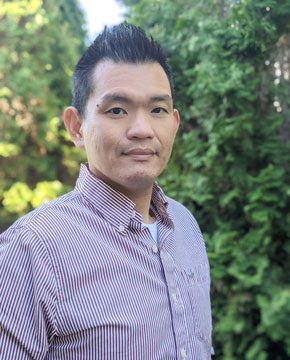
Dr. PingHsun Hsieh began his studies in computer engineering. The Assistant Professor in the Department of Genetics, Cell Biology and Development never anticipated becoming a researcher and was initially interested in the powerful capabilities of coding. But he felt that engineering was not enough. He shares, “I just felt like there was something missing, and I wanted to do more.” His advisors recommended possible pathways in finance and business. Another professor asked him, “Have you heard about the human genome?” This question sparked Dr. Hsieh’s interest.
“I started looking into genomics study and found it fascinating. Our genomes are not only a blueprint for our biology but also a history book. And they can take us back further in time.” Dr. Hsieh’s laboratory uses population genetics modeling and analyzing various types of biological data to delve into the intricate world of genomes, evolution, and human health. He focuses on understanding how evolutionary mechanisms shape the destiny of genetic mutations within populations and pinpointing specific genetic variations that likely play a role in adapting organisms to new environmental challenges.
A significant aspect of Dr. Hsieh’s research revolves around structural variants (SVs), which are substantial alterations in the genetic code, such as deletions, duplications, and variations in the number of repeated DNA sequences. Unlike single-nucleotide variants (SNVs) that involve changes to individual DNA letters, SVs affect more significant segments of DNA and consequently have a higher chance of causing observable traits or characteristics (phenotypes). These structural variants are particularly relevant in fields like medical genetics, where they are implicated in conditions such as neurodevelopmental disorders and pharmacogenetics.
Dr. Hsieh’s laboratory employs cutting-edge technologies such as single-cell/single-molecule long-read sequencing and comprehensive multi-omics analyses to tackle complex structural variants. By understanding these genetic changes, which can arise through processes like hybridization and natural selection, Dr. Hsieh’s research aims to unravel their functional roles, assess their impact on the fitness of different organisms (both human and non-human), and develop evolutionary-based approaches to advance medical practices.
When he arrived at the U of M, Dr. Hsieh found a very supportive environment. “Many colleagues reached out to discuss how they could help me, how we might collaborate too.” He also appreciated the quality of labs and research taking place here. He shares, “The individual labs really have the depth in terms of their research, but also, there is tremendous breadth, not only in GCD but across the University.” Dr. Hsieh found that his observations when visiting the U of M were actualized when he arrived. “It tells me that my instincts were right, and this is a place where I can be successful.” — Anna Freed